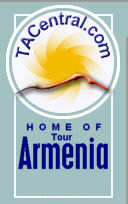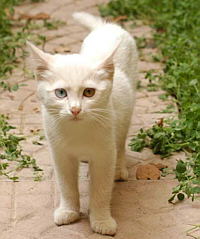Armenian Vans - real "aristocrats"
The Van cat is considered a rare breed, one of the most beautiful and certainly the most unusual breeds of a cat ever known. Vans have a long history dating back to the earliest records of Van and ancestral Armenia. They are indigenous to the Van region in the heart of historic Armenia (present day Turkey), particularly to the city of Van, on Vana Lich (Van Lake).
The cat is a natural breed, no human selection or cross-breeding has been used to establish the breed. They are also very unique, the only cats that are known to naturally swim. Vans are a bigger breed then other cats, with predominantly white fur. The Van cat's eyes are always large with eyes of three types: both eyes amber, both eyes blue, or one amber and one blue. Most of the stories about the Van cat seem to be about the blue and amber color eyed cats, perhaps because their eyes seem more expressive.
Its skin is shell-pink, and its ears have long, delicately curved inner tufts, sometimes with 'feathers' on the tips. Van cats can easily be trained, if treated sensibly, and apparently love to be with human beings. The only other colors are an amber tail and amber marks to the head.
Origin
Historic records show the Van cat on cliff-side carvings in the van region from the middle bronze age, especially proliferating in carvings done by Assyria and Urartu, the latter a forebear of the Armenian race. But as with much of what was originally Armenian, the Van cat has been mistakenly mislabeled as Turkish, which is a cause of controversy.
The cat was first exported to the West from present-day Turkey in 1955 by Laura Lushington and Sonia Halliday, two British women who were travelling through Turkey. They noticed that the cats particularly around the area of Van in current Eastern Turkey bore a remarkable resemblance to the traditional Angora type, which were heretofore known by outsiders as "Turkish cats". The most noticeable difference however was that the coat was not pure white, but had auburn head markings and a faintly ringed auburn tail. Laura brought two unrelated cats back to Britain, and when they were mated they produced kittens bearing the same auburn markings. It was at this point that Laura realized that this was a natural breed, and not man-induced.
When the club set about registering the breed, she registered the Van Cat prefix and added the word "Turkish" to the name, following the example of a Van Cat club in Turkey.
However, carvings and inscriptions found in Assyrian and Urartian records showing the cat as a favored animal or deity predate the Turkish existence in the area by 2000 to 3000 years, causing no end of consternation to present day Turkish historians.
Van cats have been the symbol of Van and the city of Van since at least the middle bronze age, some archeologists believing they developed around the same time as the Armenian Plateau cultivated wheat and livestock, beginning around 14,000 BC. One of the early records of white, semi-long hair cats with ringed tails and colour on their heads were carvings on jewelry by the Hittites (1600-1200 BC), cousins to the Armenian race. The Urartians (1st millenium BC) who settled in the City of Van (Tushpa) carved ringtail cats on ornaments. Archaeological finds in Van province of relics possibly from an ancient battle during the occupation of Armenia by the Romans (AD 75-387), including battle standards and armor bearing images of a large pale self colored cat showing distinctive rings on the cat's tail.
Even more recently, during the excavation by the British Archaeological Institute in Ankara of a late Neolithic (7000 years ago) site near Hacilar, 22 small terracotta statues said to be women playing with cats were found on one level. Because of this discovery some scientists now question the long held belief that cats were first domesticated in Egypt.
Ironically, the Turks now have a special section on their government web site about the cat, recounting that their ancestors called this cat "pisik". Pisik is a pure Armenian root word, meaning "kitten", "piso" being cat. It appears Turks want their ancestors to be Armenian, or perhaps they at least want to admit how much of their culture is due to cultures like Armenia.
Anyway, Van Cats have an international breed name of Turkish Van cat, Turks use the Armenian word 'Pisik', and it is properly called the Van Cat.
About the Van
It is generally assumed that geographic isolation is responsible for the preservation of this unique breed of cat. The most notable feature of the area of Anatolia (present day Eastern Turkey) is Lake Van in the Bznuniq region of Historic Armenia, bound by the mountains of Suphan (from the original Armenian "Sipan", or "Nekh Masiq" at 4434m a few hundred meters higher then Mt. Aragats, the tallest mountain in the Republic of Armenia at 4097m on the North summit) in the north, and Mt. Nemrut (3046m), in the Taron range to the west of Lake Van (Nemrut is like the Republic's "Arair lehr", with lake at its summit and a mythical origin). There is another Mt. Nemrut (1919m, Armenian " Ashimun Ler") to the south, near Armenia's 1st century BC capital of Tigranakert, also known as the burial place for Armenia's kings.
Among the sadder stories including the Van Cat are tales of how the Turks would use the animals as a means of torture of Armenians before and during the genocide. One tale relates how Turks would capture Armenians, strip them, and stuff them into cloth bags with Van Cats, beating the bag. The poor animals, driven into a frenzy, would lacerate the Armenian captives.
Biblical Mount Ararat is some 100 miles to the north-east. The area around Van is mountainous and suffers extremes of temperature to which the Van Cat has fully adapted, shedding its long hair for a shorter cooler coat in the summer, and with tufts of hair between its pads to protect its paws from the cold in the winter. The dominance of this region by Lake Van lends credence to the reputation bestowed on the cats of being swimming cats. This is not to suggest that all Vans like to swim, but many will do so in shallow warm water, and they love to play with running water too.
The Van is a loyal, loving and very intelligent cat. Its temperament depends greatly on its upbringing, the amount of human contact and handling it receives as a kitten, and the temperament of the mother herself. They are very affectionate, giving head butts and love bites.
Vans are great climbers, so don't be surprised to find them sitting on top of doors, kitchen units or wardrobes, and some wouldn't think twice about climbing your curtains and sitting on the curtain rail. A great game is retrieving screwed up paper, some catching the ball of paper in mid flight, others making great somersaults.
Where water is concerned, some are not very keen at all, whereas others may love dripping taps, especially drinking from them, then flicking the water with their paws, or dropping toys into their water bowl. It has been known for Vans to swim in the bath, swimming pool or even the sea. Some sources recount that Vans will dive up to 9 meters to catch fish in Lake Van.
They like to be involved in everything their owners do and follow them around like a dog. In fact some people have said that Van cats are more like dogs than cats. On the whole, they get on very well with dogs indeed, but the Van Cat will want to be the boss. In most instances the females are more independent and if you have a male and female, she will normally rule the roost, but there are always the exceptions.
Web sites
Web site links are taken from the resources pages at The Van Site web site, an extremely thorough and informative web site. We are grateful for the expert research.
Pairodocs Vans Deb's pages with more information on Turkish Vans
Vhantoms Vans nice cat graphics and interesting geographical references on the Vans
Vantastix Cat Club CFA's Turkish Van breed club
Van Cat Club - UK this UK site has been revamped and has lots of info
Vantasia Classic Turkish Van Association in England
Vangora - Finland neat screensaver and lots of pictures of beautiful Vans
Svampens Home Page lovely pictures of their beautiful Turkish Van cats
Yeniraki check out the Turkish imports
Darlingtonia Meet their lovely Turkish Vans at this Danish Site
Glasbach Cats Visit our friend Beate's lovely Vans in Germany
And another cattery from the Netherlands




